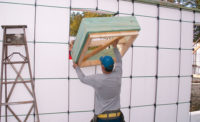
How one insulation expert is helping the architectural and construction communities understand the value of taking a systematic approach to soundproofing.
In the world of acoustics and soundproofing, specialists abound. Coming in during the last stages of construction or renovation, these sound gurus bring their acoustical expertise to bear on what is essentially a finished room or building. The walls are framed, the floors are in place and most of the heavy lifting is done. At this point the specialist enters to advise on which soundproofing products the contractor should use.
For Yanky Drew, founder of TMSoundproofing, this approach is akin to closing the barn door after the horse has bolted.
“The goal should always be to build a room that’s quiet-not to go into a finished structure and only then start thinking about reducing noise,” says Drew. “It’s vital to work with contractors at the very start of a project – the earlier in the process you use soundproofing technologies, the better result you can achieve.”
Drew’s no-nonsense approach to noise reduction stems in large part from his industry background. Rather than coming from the specialty acoustics field, he started with a traditional insulation company in 2004. As he developed relationships with builders, contractors and customers, he found more and more requests to put in insulation to soundproof floors, walls, bathrooms and bedrooms come his way.
“The problem was, it never really worked that well,” he remembers. “People kept asking us what else we had that we could put in to block off the noise.”
This seemingly simple request led to nearly two years of research into different soundproofing methods and technologies available on the market. Beginning his search on the Internet, Drew quickly realized that there was too much information out there that was dated, biased or just plain wrong. He decided to reach out to his associates in the construction industry, calling builders and contractors about specific products like soundboard or MLV, asking how they worked, and then visiting sites to see the technologies in action.
Product Research
It was at around this time that Drew first began to see the Green Glue name featured in the media and online. Consisting of the company’s flagship viscoelastic compound, as well as other noiseproofing technologies such as the sealant, joist tape and clips, the product came together as a system to decrease noise transmission.In 2007, with his research complete, Drew was ready to open a separate company, TMSoundproofing, to consult and work solely on sound insulation projects.
Drew’s first client for TMSoundproofing was the Beit Shvidler Conference Center, a small luxury hotel in Monsey, N.Y. With only 25 rooms, the hotel had built its reputation around quality, service and exclusivity and was now looking to soundproof its rooms to enhance guests’ experiences.
Drew decided to choose a simple approach: Each room was soundproofed with Resilient Sound Clips on one side and Green Glue Noiseproofing Compound on the other. Working with his crew, the rooms were completed in short order.
“For hotels, guest experience is everything. TMSoundproofing and the Beit Shvidler Conference Center had essentially staked our reputations on Green Glue, so we were gratified and relieved to find it working so well,” Drew says.
The real proof came later on when a foreman was contracted to take out an adjoining door between rooms in the same hotel and fill it in so that it was flush with the existing wall. Because Drew had used resilient sound clips (which decouple a wall from the frame) and and two layers of drywall to sandwich the Green Glue, it took five layers drywall to fill in the gap. One of the original ways to reduce sound is to add mass to a wall, but even this much drywall couldn’t compete with TMSoundproofing’s solution.
When he went back to test the quality of noise reduction, he had to give Drew a call, “Despite those five layers of drywall, he could still hear music in the adjoining room when passing the filled-in door,” Drew remembers. “When he passed the walls we’d treated-he heard nothing.”
How Systems Work
Attention to detail, Drew explains, is critical. Understanding how soundproofing products work as a complete system has enabled him to work through and offer solutions to problems that contractors face in construction and renovation.“When we were brought in to soundproof entire floors or buildings, we’d find that even if we treated the floors and ceilings, noise would still escape. It was a mystery at first, until I started working on the projects much earlier in the construction process. Then the problem became obvious to me-although we were soundproofing the floors, we weren’t doing anything to the floors that ran under the walls,” says Drew. “Those bits were completely untreated and the sound was traveling smoothly down between floors.”
Drew realized at once that he needed to get in front of builders before they ever began framing the walls. At that point, he was able to have them install two layers of subfloor-with soundproofing in between-that ran across the whole building. Once the walls were framed, the noise was gone as sound would still travel down the wall but each time the subfloor stopped it from crossing over into the room above or below.
“This is really where I see TMSoundproofing adding value,” he says. “We’re not just selling the products. I’m on job sites every day, working with the Green Glue system, seeing how it behaves under varying construction conditions and coming up with ideas to improve the installation.”
Drew’s idea of soundproofing the subfloor before framing the walls has been used on numerous projects and is one of the top solutions he promotes to builders. More importantly, it has led to a key lesson-in any construction project it is critical to get a dialogue on soundproofing started early so you have more options available for addressing noise problems.
“If you’re brought in to soundproof a room that’s essentially already built, you’re very limited in what you can achieve. You need to get in front of the contractors-and ideally the architects-from the very beginning,” he adds. ”That way, you can recommend a solution from a wider breadth of soundproofing options and end up with a far better end result.”
Drew’s hands-on experience in the field has led him conclude that professional soundproofing shouldn’t be just about going into an existing room and finding ways to reduce the noise. “We need to be there at the start of construction to make sure we are building quiet rooms,” he notes.




